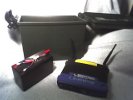|
I do volunteer work for the American Red Cross, New Jersey Region, on the Disaster Services Technology (DST) team. About 3 weeks before the recent visit of Pope Francis to the United States, I was contacted by Fred, WW2VEH, to discuss a backup plan to cover communications in cities in several states: New York City, Fairfield, NJ, Tinton Falls, NJ, and Philadelphia. What made this discussion interesting was that 3 Red Cross regions needed to communicate for one event, a situation not normally encountered. Fred asked me if I could put together some sort of phone system that could be deployed to these 3 cities as well as several field locations. Using elements of technology from amateur mesh operations and the AllStar Link Network, I was able to deploy a system across those cities using voip phones, an AllStar repeater node and remote base station, and mesh tunnels. Tying this all together was an Asterisk PBX.
Each city had one or two phones tied back to the main AllStar pbx. A tunnel server was established at the pbx end on a Ubiquity Nano station and tunnel clients using Linksys routers were established at each of the
locations with phone(s). A dial plan was established enabling the phones to directly dial each other. Behind each phone there was voice mail as well a conference bridge available to all users. In the background, a
number of test extensions were configured on the pbx to assist with provisioning the network. At Tinton Falls, 3 phones were set up: one directly off the tunnel client and two others via mesh on 2.4 GHz. Philadelphia had one phone, Fairfield had two phones and New York City had two phones.
Midway through the operation, a remote base station was established on the NJ OEM 222 MHz repeater. This was made available to all users through a special extension number.
All but one of the tunnel clients came up without incident. The one that did not come up was blocked by corporate firewall rules which did not allow unusual ports to leave the premises. All the phones worked well, except for one phone via mesh. The remote base station worked well, even though it was a 1 watt portable talking to a repeater 40 miles away with an attic mounted antenna.
None of the field locations were activated. However, in preparation for activating one location, a ViaSat satellite link was set up in the parking lot of Tinton Falls. A tunnel client was established over this link and the voip phone came up fine. Several calls were placed over this phone, and other than a long turn-around time, voice quality was good.
Some takeaways:
- The phone that did not work via mesh was on a Part 15 channel. During the operation, Red Cross personnel did all their work via wireless
laptops, between 20 and 30 units. In the future, phones connected this way will need to be using ham band only channels.
- To remedy the problem of the client node being blocked by a firewall, perhaps a design change could be made allowing port 80 or maybe 443 to be used for tunnels.
Some pictures can be seen on the mesh at
http://n2mh-meshphone2/redcross/pope
Weblinks
AllStarLink Network
https://allstarlink.org/
AllStar on a BeagleBone Black or Raspberry Pi 2
http://crompton.com/hamradio/BeagleBoneBlackAllstar/
73, Mark, N2MH |
